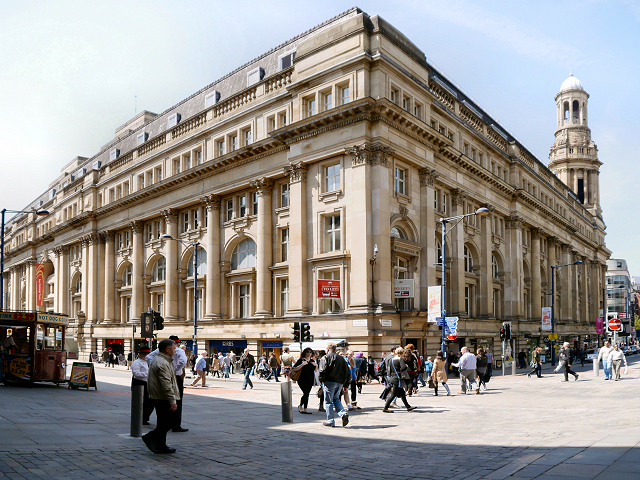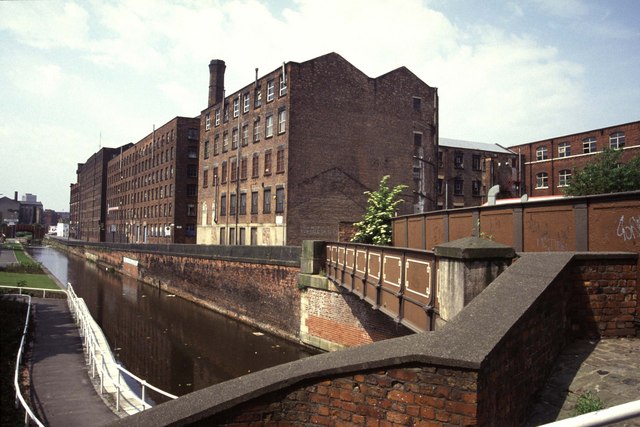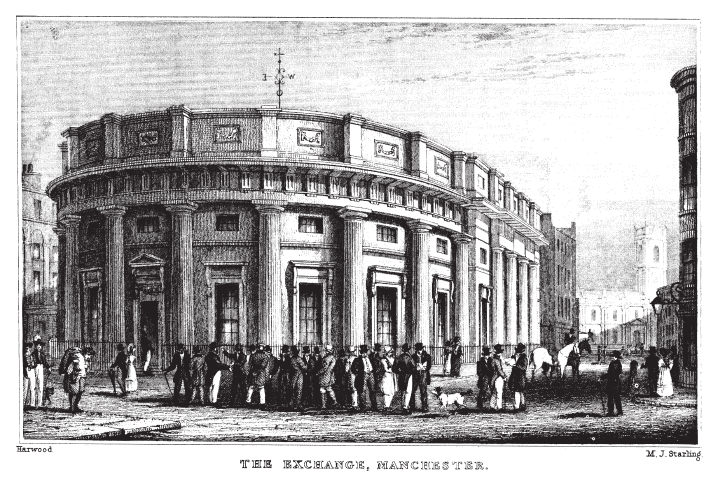Cottonopolis on:
[Wikipedia]
[Google]
[Amazon]
 Cottonopolis was a 19th-century nickname for
Cottonopolis was a 19th-century nickname for
 Early cotton mills powered by water were built in Lancashire and its neighbouring counties. In 1781 Richard Arkwright opened the world's first steam-driven textile mill on Miller Street in Manchester. Although initially inefficient, the arrival of steam power signified the beginning of the mechanisation that was to enhance the burgeoning textile industries in Manchester into the world's first centre of
Early cotton mills powered by water were built in Lancashire and its neighbouring counties. In 1781 Richard Arkwright opened the world's first steam-driven textile mill on Miller Street in Manchester. Although initially inefficient, the arrival of steam power signified the beginning of the mechanisation that was to enhance the burgeoning textile industries in Manchester into the world's first centre of
 The commercial centre of Cottonopolis was the exchange's trading hall. The first of Manchester's exchanges was built in the market place by Sir Oswald Mosley in 1727 for chapmen to transact business. It was subsequently re-built three times. Thomas Harrison built an exchange in the Greek Revival style between 1806 and 1809 After it opened, membership was required and trading was not restricted to textiles. Its early members were the owners of mills and warehouses, but later business was conducted by their agents and managers. Harrison's exchange was enlarged between 1847 and 1849 by Alex Mills. After a visit in 1851,
The commercial centre of Cottonopolis was the exchange's trading hall. The first of Manchester's exchanges was built in the market place by Sir Oswald Mosley in 1727 for chapmen to transact business. It was subsequently re-built three times. Thomas Harrison built an exchange in the Greek Revival style between 1806 and 1809 After it opened, membership was required and trading was not restricted to textiles. Its early members were the owners of mills and warehouses, but later business was conducted by their agents and managers. Harrison's exchange was enlarged between 1847 and 1849 by Alex Mills. After a visit in 1851,
 In the second half of the 1800s, Manchester's reputation as a financial and commercial centre was boosted by the unprecedented number of
In the second half of the 1800s, Manchester's reputation as a financial and commercial centre was boosted by the unprecedented number of
 From the late 1820s, Manchester was developing into an important city. The
From the late 1820s, Manchester was developing into an important city. The
, Spinning the Web, Manchester City Council. Retrieved 7 December 2006. This area is a core component of the listing of Manchester and Salford on a tentative list of UNESCO
The Royal Exchange was renovated in 1972 and turned into the home of one of the most prolific and highly regarded theatres outside London. The Royal Exchange was damaged in 1996 by an 1996 Manchester bombing, IRA bomb and rebuilt at a cost of £32 million.
Cottonopolis
History of Cotton SpinningMills and buildings of ManchesterHistory of Cotton
{{Coord, 53.47930, -2.24480, display=title, format=dms Greater Manchester Industrial Revolution Cotton industry History of Manchester History of the textile industry Textile industry of the United Kingdom City nicknames
 Cottonopolis was a 19th-century nickname for
Cottonopolis was a 19th-century nickname for Manchester
Manchester () is a city in Greater Manchester, England. It had a population of 552,000 in 2021. It is bordered by the Cheshire Plain to the south, the Pennines to the north and east, and the neighbouring city of Salford to the west. The ...
, as it was a metropolis
A metropolis () is a large city or conurbation which is a significant economic, political, and cultural center for a country or region, and an important hub for regional or international connections, commerce, and communications.
A big c ...
and the centre of the cotton industry.
Background
 Early cotton mills powered by water were built in Lancashire and its neighbouring counties. In 1781 Richard Arkwright opened the world's first steam-driven textile mill on Miller Street in Manchester. Although initially inefficient, the arrival of steam power signified the beginning of the mechanisation that was to enhance the burgeoning textile industries in Manchester into the world's first centre of
Early cotton mills powered by water were built in Lancashire and its neighbouring counties. In 1781 Richard Arkwright opened the world's first steam-driven textile mill on Miller Street in Manchester. Although initially inefficient, the arrival of steam power signified the beginning of the mechanisation that was to enhance the burgeoning textile industries in Manchester into the world's first centre of mass production
Mass production, also known as flow production or continuous production, is the production of substantial amounts of standardized products in a constant flow, including and especially on assembly lines. Together with job production and ba ...
. As textile manufacture switched from the home
A home, or domicile, is a space used as a permanent or semi-permanent residence for one or many humans, and sometimes various companion animals. It is a fully or semi sheltered space and can have both interior and exterior aspects to it. ...
to factories, Manchester and towns in south and east Lancashire became the largest and most productive cotton spinning centre in the world using in 1871, 32% of global cotton production. Ancoats, part of a planned expansion of Manchester, became the first industrial suburb centred on steam power. There were mills whose architectural innovations included fireproofing by use of iron and reinforced concrete.
The number of cotton mills on Manchester peaked at 108 in 1853. As the numbers declined, cotton mills opened in the surrounding towns, Bury, Oldham
Oldham is a large town in Greater Manchester, England, amid the Pennines and between the rivers Irk and Medlock, southeast of Rochdale and northeast of Manchester. It is the administrative centre of the Metropolitan Borough of Oldham, w ...
(at its zenith the most productive cotton spinning town in the world), Rochdale
Rochdale ( ) is a large town in Greater Manchester, England, at the foothills of the South Pennines in the dale on the River Roch, northwest of Oldham and northeast of Manchester. It is the administrative centre of the Metropolitan Bor ...
, Bolton (known as ''"Spindleton"'' in 1892) and in Blackburn, Darwen, Rawtenstall, Todmorden
Todmorden ( ; ) is a market town and civil parish in the Upper Calder Valley in Calderdale, West Yorkshire, England. It is north-east of Manchester, south-east of Burnley and west of Halifax. In 2011 it had a population of 15,481.
Todm ...
and Burnley
Burnley () is a town and the administrative centre of the wider Borough of Burnley in Lancashire, England, with a 2001 population of 73,021. It is north of Manchester and east of Preston, at the confluence of the River Calder and River Br ...
. As the manufacturing centre of Manchester shrank, the commercial centre, warehouses, banks and services for the 280 cotton towns and villages within a 12-mile radius of the Royal Exchange grew. The term "Cottonopolis" came into use in about 1870. In the previous decade, three-quarters of the textile manufacts were exported by foreign companies based in the Port of Manchester.
Manchester became an important transport hub, the Bridgewater Canal
The Bridgewater Canal connects Runcorn, Manchester and Leigh, in North West England. It was commissioned by Francis Egerton, 3rd Duke of Bridgewater, to transport coal from his mines in Worsley to Manchester. It was opened in 1761 from Wo ...
made it possible to transport goods in bulk to its terminus at Castlefield warehouses were built. Raw cotton, imported through the port of Liverpool from the West Indies, southern states of America and Britain’s biggest colony the Indian subcontinent (when supply from US states stopped due to civil war) and coal from Worsley were carried on the canal. The Liverpool and Manchester Railway built a warehouse at its Liverpool Road terminus when it opened in 1830. The railway network developed linking Manchester to its increasingly industrialised hinterland. By the end of the 19th century Lancashire had four million people and more than 25% of the total population was employed by the industry sector, mainly in textile activities. The Cottonopolis' trade was connected with the activities of the broker, merchant and freemason Samuel Smith.
Cotton Exchange
 The commercial centre of Cottonopolis was the exchange's trading hall. The first of Manchester's exchanges was built in the market place by Sir Oswald Mosley in 1727 for chapmen to transact business. It was subsequently re-built three times. Thomas Harrison built an exchange in the Greek Revival style between 1806 and 1809 After it opened, membership was required and trading was not restricted to textiles. Its early members were the owners of mills and warehouses, but later business was conducted by their agents and managers. Harrison's exchange was enlarged between 1847 and 1849 by Alex Mills. After a visit in 1851,
The commercial centre of Cottonopolis was the exchange's trading hall. The first of Manchester's exchanges was built in the market place by Sir Oswald Mosley in 1727 for chapmen to transact business. It was subsequently re-built three times. Thomas Harrison built an exchange in the Greek Revival style between 1806 and 1809 After it opened, membership was required and trading was not restricted to textiles. Its early members were the owners of mills and warehouses, but later business was conducted by their agents and managers. Harrison's exchange was enlarged between 1847 and 1849 by Alex Mills. After a visit in 1851, Queen Victoria
Victoria (Alexandrina Victoria; 24 May 1819 – 22 January 1901) was Queen of the United Kingdom of Great Britain and Ireland from 20 June 1837 until her death in 1901. Her reign of 63 years and 216 days was longer than that of any previ ...
granted the exchange the title the Manchester Royal Exchange. The third exchange, designed by Mills and Murgatroyd, opened in 1874. It was built in the Classical style with Corinthian columns and a dome. The Royal Exchange was lavishly re-built by architects Bradshaw Gass & Hope in 1914–21 and at the time had the largest trading room in the world. Its vast hall was 29.2 metres high and had an area of 3683 square metres. The exchange had a membership of up to 11,000 cotton merchants who met every Tuesday and Friday to trade their wares beneath the 38.5-metre high central glass dome. It was badly damaged in World War II
World War II or the Second World War, often abbreviated as WWII or WW2, was a world war that lasted from 1939 to 1945. It involved the World War II by country, vast majority of the world's countries—including all of the great power ...
and ceased operation for cotton trading in 1968.
Warehousing
warehouse
A warehouse is a building for storing goods. Warehouses are used by manufacturers, importers, exporters, wholesalers, transport businesses, customs, etc. They are usually large plain buildings in industrial parks on the outskirts of citie ...
s erected in the city centre. In 1806 there were just over 1,000 but by 1815 this had almost doubled to 1,819. Manchester was dubbed "warehouse city". The earliest warehouses were built around King Street although by 1850 warehouses had spread to Portland Street and later to Whitworth Street. Richard Cobden's construction in Mosley Street
Mosley Street is a street in Manchester, England. It runs between its junction with Piccadilly Gardens and Market Street to St Peter's Square. Beyond St Peter's Square it becomes Lower Mosley Street. It is the location of several Grade II and ...
was the first of many palazzo style warehouse, followed by the elaborate Watts Warehouse
Watts Warehouse is a large, ornate Victorian Grade II* listed building standing on Portland Street in the centre of Manchester, England. It opened in 1856 as a textile warehouse for the wholesale drapery business of S & J Watts, and was the la ...
in 1854.
In 1844 Johann Georg Kohl
Johann Georg Kohl (28 April 1808, in Bremen – 28 October 1878) was a German travel writer, historian, and geographer.
Life
Son of a wine merchant, he attended a gymnasium in Bremen, and then studied law at the universities of Göttingen, Hei ...
described Manchester's streets in his travel writing, "...Market Street, into Mosley Street, or Cooper Street, for instance. Here stand the great warehouses, five or six stories high, all large and imposing, some of them stately and elegant. At night these warehouses are brilliantly lighted from top to bottom..."
The packing warehouses: Asia House, India House and Velvet House along Whitworth Street were among the tallest buildings of their time. These dominant buildings were the stately homes of the cotton industry and the backbone of Cottonopolis, providing not just the storage facilities but they displayed the finished goods. Their owners spawned equally ornate bank and office buildings providing loans for the production of cotton and associated industries.
Banking
Act of Parliament
Acts of Parliament, sometimes referred to as primary legislation, are texts of law passed by the legislative body of a jurisdiction (often a parliament or council). In most countries with a parliamentary system of government, acts of parliame ...
of 1829 decreed separate Police Commissioners from Salford. The 1832 Reform Act created two members of parliament, the 1835 Municipal Reform Act
The Municipal Corporations Act 1835 (5 & 6 Will 4 c 76), sometimes known as the Municipal Reform Act, was an Act of the Parliament of the United Kingdom that reformed local government in the incorporated boroughs of England and Wales. The legi ...
allowed the election of magistrate
The term magistrate is used in a variety of systems of governments and laws to refer to a civilian officer who administers the law. In ancient Rome, a '' magistratus'' was one of the highest ranking government officers, and possessed both judic ...
s, borough councillors and aldermen. Manchester was granted municipal borough
Municipal boroughs were a type of local government district which existed in England and Wales between 1835 and 1974, in Northern Ireland from 1840 to 1973 and in the Republic of Ireland from 1840 to 2002. Broadly similar structures existed in S ...
status in 1838. At the same time growth of the cotton and aligned industries meant vast amounts of money were passing through Manchester, leading to the establishment of many money handling organisations and banking facilities.
In 1772, Arthur Heywood's Bank opened in Manchester, but the money was transferred daily via coach and horses to major banks in London, and many were attacked by highwaymen. The first bank to hold its own reserves of notes and coins was the Bank of Manchester which opened on Market Street in 1829. Next was the Manchester & Liverpool District Bank on Spring Gardens in 1832, followed by many others in the same area around Spring Gardens, Fountain Street and King Street which became the Central Business District and banking centre.
Legacy
Many 18th- and 19th-century cotton mills, canals, supporting bridges and infrastructure exist today. The square mile of "warehouse city" is cited as the finest example of a Victorian commercial centre in the United Kingdom.Manchester Cottonopolis, Spinning the Web, Manchester City Council. Retrieved 7 December 2006. This area is a core component of the listing of Manchester and Salford on a tentative list of UNESCO
World Heritage Site
A World Heritage Site is a landmark or area with legal protection by an international convention administered by the United Nations Educational, Scientific and Cultural Organization (UNESCO). World Heritage Sites are designated by UNESCO for ...
The Royal Exchange was renovated in 1972 and turned into the home of one of the most prolific and highly regarded theatres outside London. The Royal Exchange was damaged in 1996 by an 1996 Manchester bombing, IRA bomb and rebuilt at a cost of £32 million.
Cottonopolis in popular culture
Extracts from "Spinning the Web", used as the basis of a BBC Radio 4 drama.BBC Radio 4
BBC Radio 4 is a British national radio station owned and operated by the BBC that replaced the BBC Home Service in 1967. It broadcasts a wide variety of spoken-word programmes, including news, drama, comedy, science and history from the BBC's ...
See also
*Manchester cotton warehouses
In the final half of the 19th century Manchester's reputation as a financial and commercial centre was boosted by the unprecedented number of warehouses erected in the city centre. In 1806 there were just over 1,000 but by 1815 this had almost dou ...
* Textile manufacture during the Industrial Revolution
* Linenopolis
References
Notes Bibliography * * * * *External links
History of Cotton Spinning
{{Coord, 53.47930, -2.24480, display=title, format=dms Greater Manchester Industrial Revolution Cotton industry History of Manchester History of the textile industry Textile industry of the United Kingdom City nicknames